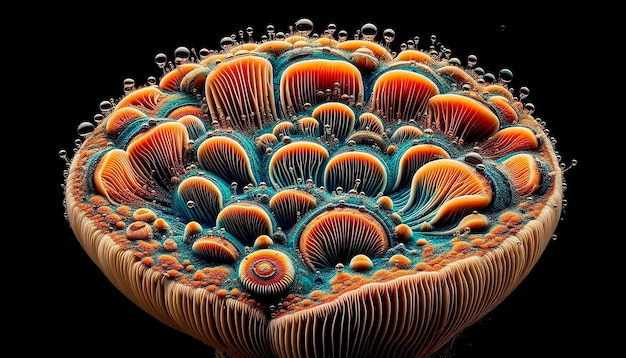In a groundbreaking study published recently, scientists have successfully sequenced and analyzed the mitogenome of the Subarctic octocoral, shedding light on the genetic intricacies of this lesser-known marine species. Conducted by a team of researchers, including Alisa Heuchel, Åse Emblem, Tor Erik Jørgensen, Truls Moum, and Steinar Daae Johansen, this research utilized advanced Ion Torrent sequencing technology to delve into the mitochondrial DNA of the Norwegian octocoral isolate. The study unveiled a complete mitogenome consisting of 18,790 base pairs, which includes a suite of 17 essential genes.
This comprehensive genetic analysis not only confirms the presence of 14 protein subunits, two structural ribosomal RNAs, and one tRNA typical of octocorals but also identifies a novel tRNA-like gene within the MutS protein coding region. Interestingly, this newly discovered gene feature appears to be a conserved element across various octocoral species, although it had not been documented before. Additionally, the researchers discovered an optional gene (ORFA) encoding a mysterious protein of 191 amino acids, the function of which remains to be elucidated.
The findings from this study also contribute significantly to the phylogenetic understanding of octocorals. A mitogenome-based phylogenetic tree places the Subarctic octocoral in close relation with species from the Mediterranean Sea and the Southeast Pacific Ocean, suggesting intriguing biogeographical connections that warrant further investigation. This research not only enhances our understanding of octocoral genetics but also underscores the importance of studying Subarctic marine biodiversity.
The study focusing on the Subarctic octocoral mitogenome builds upon a rich history of marine biology research that seeks to decode the secrets held by the genetic material of less commonly studied marine organisms. The Subarctic regions, characterized by their cold and often nutrient-rich waters, provide a unique habitat for numerous marine species, including octocorals. These environments, while harsh, are biodiverse and hold key insights into how life adapts to extreme conditions. The Subarctic octocoral, known for its resilience and adaptability, is an excellent candidate for such genetic studies.
Octocorals, a subgroup of cnidarians, which also include the more familiar stony corals and sea anemones, are particularly noteworthy due to their intricate symbiotic relationships and their contribution to marine biodiversity as ecosystem engineers. Unlike their tropical relatives, the biology and genetic makeup of Subarctic octocorals are not well-documented, making this study an important milestone in marine genetic research. By unlocking the genetic code of these organisms, scientists can begin to understand the broader ecological and evolutionary narratives of the Subarctic marine ecosystems.
Before this groundbreaking research, the majority of genetic studies on octocorals were concentrated on specimens from more temperate and tropical regions. The genetic isolation and distinct environmental conditions of the Subarctic species hinted at potential genetic novelties and adaptations unseen in their warmer-water cousins. This anticipation propelled the research team to undertake the complex task of sequencing the Subarctic octocoral mitogenome using the Ion Torrent sequencing technology, a method known for its speed and accuracy in decoding DNA.
The study’s novel findings, such as the discovery of a tRNA-like gene within the MutS protein coding region and the optional gene ORFA, are particularly crucial. These genetic elements may play roles in the stress responses and metabolic adaptations necessary for survival in the Subarctic’s cold waters. The identification of these genes opens pathways for further research, possibly leading to insights into how genetic adaptations can influence an organism’s survival amid changing climates and environmental stressors.
Moreover, the phylogenetic analysis provided by this research offers a new perspective on the biogeographical history of octocorals. By placing the Subarctic octocoral in a phylogenetic framework alongside relatives from distinctly different marine environments, this study paves the way for future ecological and evolutionary studies that span multiple geographies and climates.
In sum, the completion of the mitogenome for the Subarctic octocoral marks a significant advancement in the field of marine genomics. It enriches our understanding of the genetic architecture and evolutionary trajectories of Subarctic marine life, emphasizing the critical nature of preserving and further studying these lesser-known ecosystems. The continuing research into the Subarctic octocoral mitogenome not only enhances our biological knowledge but also our ability to make informed conservation decisions in the face of global environmental challenges.
The methodology employed in the groundbreaking study on the Subarctic octocoral mitogenome involved several innovative and meticulous steps designed to accurately sequence and analyze the genetic makeup of this distinctive marine organism. The research hinged on the use of the advanced Ion Torrent sequencing technology, which is notable for its efficiency and accuracy in mitochondrial DNA analysis. Here is a detailed breakdown of the methodology used:
1. **Sample Collection and Preparation**: Researchers collected specimens of the Subarctic octocoral from carefully selected sites in the Norwegian oceans known for their cold, nutrient-rich waters. The specimens underwent a preservation process to protect the integrity of the DNA, which included freezing the samples immediately post-collection to prevent degradation.
2. **DNA Extraction**: The team employed a specialized method for extracting mitochondrial DNA from the frozen tissue of the octocorals. This step was crucial for ensuring that the DNA was intact and of sufficient quality and quantity for sequencing.
3. **Library Preparation and Sequencing**: Using the Ion Torrent platform, researchers prepared DNA libraries that were tailored for mitochondrial DNA sequencing. This involved tagging the DNA with specific markers that facilitate the sequencing process. The sequencing technology provided by Ion Torrent utilizes semiconductor technology to detect hydrogen ions released during the DNA polymerization process, offering rapid and accurate sequencing outputs.
4. **Sequence Assembly and Annotation**: The sequencing data obtained was then assembled using sophisticated bioinformatics tools designed to construct a complete mitogenome sequence from the short reads provided by the Ion Torrent system. Annotation of the assembled sequence was performed to identify and map the genes within the mitochondrial DNA, including any novel or unusual genes, like the tRNA-like gene found within the MutS protein coding region.
5. **Phylogenetic Analysis**: To understand the evolutionary relationships and biogeographical history of the Subarctic octocoral, the complete mitogenome was compared against known sequences from other octocoral species across the world. This analysis utilized advanced phylogenetic software, which facilitated the creation of a phylogenetic tree showing the Subarctic octocoral’s relation to species from diverse environments like the Mediterranean Sea and the Southeast Pacific Ocean.
6. **Data Interpretation and Validation**: After sequencing and analysis, the results were carefully interpreted in the context of existing genetic and ecological research. Further validation was performed through peer review and additional experiments to confirm the presence of identified genes and their potential functions.
This rigorous methodology not only elucidated the complete Subarctic octocoral mitogenome but also opened new avenues for understanding the genetic adaptations and biodiversity of Subarctic marine life. The study’s deployment of Ion Torrent sequencing technology specifically contributed to the high-resolution insights into the mitochondrial genome, which are vital for furthering conservation efforts and ecological studies in harsh marine environments. Through this approach, the researchers have significantly advanced our knowledge of the genetic architecture of less commonly studied marine organisms, highlighting the critical nature of innovative genetic research in understanding global biodiversity.
The recently published research on the Subarctic octocoral mitogenome constitutes a significant leap in our understanding of the genetic basis and evolutionary relationships of these little-explored marine organisms. By successfully sequencing the complete mitochondrial genome of a specimen from the cold, nutrient-rich waters of the Norwegian seas, this study has provided intriguing insights into the genetic architecture of Subarctic octocorals. The mitogenome, comprising 18,790 base pairs, contains 17 essential genes, which include 14 for protein subunits, two ribosomal RNAs, and one tRNA, shedding new light on the essential genetic components of octocorals.
One of the key findings from the research is the identification of a novel component within the mitochondrial genome. A tRNA-like gene was discovered nested within the coding region of the MutS protein, a gene involved in DNA repair mechanisms. This gene appears to be conserved across various octocoral species, suggesting an evolutionary significance that was previously undocumented. The presence of this tRNA-like gene could offer insights into possible unique regulatory mechanisms specific to octocorals.
Additionally, the researchers identified an optional gene (ORFA) that encodes a mysterious protein of 191 amino acids. The function of this protein is yet to be determined, but its identification opens up new areas for research into protein functions in octocorals, particularly in understanding how these proteins may play roles in the organism’s adaptability and survival in Subarctic conditions.
Phylogenetically, the study places this Subarctic octocoral in close relation with octocoral species found in the Mediterranean Sea and the Southeast Pacific Ocean. This biogeographical link provides a foundation for hypothesizing about past migration patterns and genetic drift scenarios, which could have led to the current distribution of these species. These findings hint at complex evolutionary histories and environmental adaptations, illuminating the movement and diversification of octocoral species across different marine environmental settings.
The study of the Subarctic octocoral mitogenome is not only key to unlocking genetic and evolutionary pathways specific to Subarctic marine life but also enhances broader ecological and evolutionary discussions related to global marine biodiversity. The findings underscore the resilience and adaptability of octocorals, pointing to genetic features that might underlie these traits.
Through the high resolution and accuracy provided by the Ion Torrent sequencing technology employed in this study, a comprehensive and finely detailed mitogenome map was produced. This technological application was crucial in identifying both the well-conserved and the peculiar genetic features of the Subarctic octocoral, providing a deep dive into the mitogenomic structure that defines this resilient marine organism. The study’s contributions are therefore pivotal, not only for academia but for strategies aimed at conservation and the understanding of ecological impacts in response to climate changes affecting marine environments.
In conclusion, the exploration and sequencing of the Subarctic octocoral mitogenome present an important milestone in marine biology, highlighting critical genetic elements that pave the way for future research into the adaptations and lineage diversification of octocorals living in extreme and changing environments.
The groundbreaking research on the Subarctic octocoral mitogenome represents a landmark achievement in marine biology, emphasizing the importance of genetic studies on lesser-known marine species, particularly those inhabiting extreme environments like the Subarctic regions. By unraveling the complete mitochondrial genome of the Subarctic octocoral, the study not only improves our fundamental understanding of the genetic makeup of octocorals but also provides crucial insights into their evolutionary trajectories and biogeographical histories.
Looking to the future, the findings from this research open several avenues for further investigation. One immediate area of interest is the functional analysis of the novel tRNA-like gene and the mysterious ORFA gene discovered in the Subarctic octocoral mitogenome. Understanding the roles of these genes could reveal mechanisms of adaptation and resilience that are critical for survival in the harsh Subarctic marine environments. Further experimental studies, possibly involving gene expression analysis and functional assays, would be instrumental in deciphering the biological significance of these genes.
Additionally, expanding the research to include more specimens from various Subarctic locations could provide a broader genetic context and help clarify the phylogenetic relationships and genetic diversity among Subarctic octocorals. Such studies would enhance our understanding of population dynamics, migration patterns, and ecological niches within these cold marine ecosystems.
The implications of this research are vast, extending beyond academic curiosity. Given the challenges posed by climate change, particularly in sensitive and rapidly changing Subarctic environments, the study of the Subarctic octocoral mitogenome could contribute significantly to conservation strategies. Knowledge of genetic adaptation mechanisms in these organisms could inform efforts to preserve biodiversity and manage ecosystems that are at risk from environmental changes.
Moreover, the methodological advances demonstrated in this study, particularly the use of Ion Torrent sequencing technology, set a new standard for genetic research in marine species. Future studies might adapt these techniques to explore other cryptic or endangered marine organisms, broadening our genetic knowledge and helping to maintain the health and diversity of marine ecosystems.
In conclusion, the extensive analysis of the Subarctic octocoral mitogenome not only fills a significant gap in our existing knowledge of marine genomics but also establishes a scientific benchmark for further ecological and evolutionary studies. As researchers continue to explore these genetic frontiers, the insights gained from the Subarctic octocoral mitogenome will undoubtedly prove integral to our ongoing efforts to understand and preserve the rich tapestry of life in our oceans. The adaptability and resilience encoded in the genes of such remarkable organisms hold the key to understanding broader global patterns of marine life and their response to an ever-changing world.









